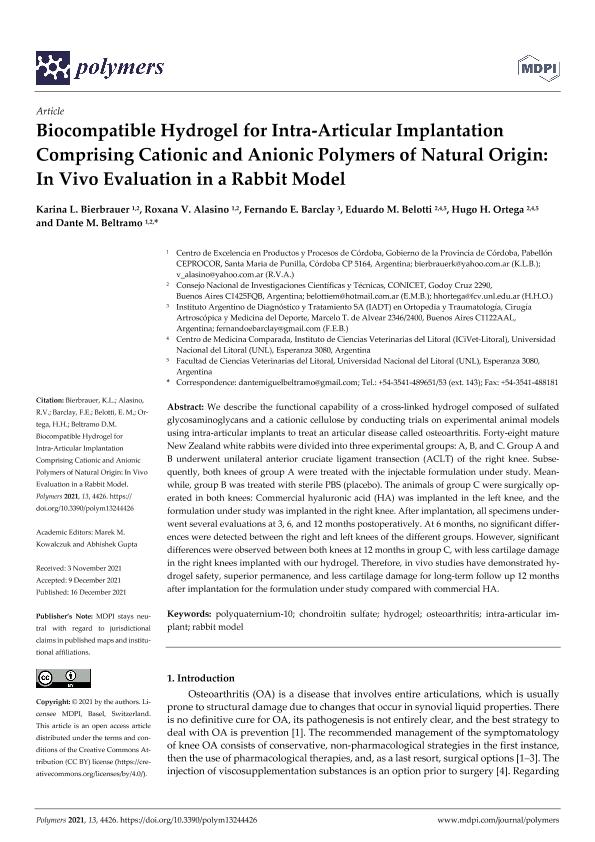Artículo
Biocompatible hydrogel for intra-articular implantation comprising cationic and anionic polymers of natural origin: In vivo evaluation in a rabbit model
Bierbrauer, Karina Lilian ; Alasino, Roxana Valeria
; Alasino, Roxana Valeria ; Barclay, Fernando E.; Belotti, Eduardo Matías
; Barclay, Fernando E.; Belotti, Eduardo Matías ; Ortega, Hugo Hector
; Ortega, Hugo Hector ; Beltramo, Dante Miguel
; Beltramo, Dante Miguel
 ; Alasino, Roxana Valeria
; Alasino, Roxana Valeria ; Barclay, Fernando E.; Belotti, Eduardo Matías
; Barclay, Fernando E.; Belotti, Eduardo Matías ; Ortega, Hugo Hector
; Ortega, Hugo Hector ; Beltramo, Dante Miguel
; Beltramo, Dante Miguel
Fecha de publicación:
12/2021
Editorial:
MDPI
Revista:
Polymers
ISSN:
2073-4360
Idioma:
Inglés
Tipo de recurso:
Artículo publicado
Clasificación temática:
Resumen
We describe the functional capability of a cross-linked hydrogel composed of sulfated glycosaminoglycans and a cationic cellulose by conducting trials on experimental animal models using intra-articular implants to treat an articular disease called osteoarthritis. Forty-eight mature New Zealand white rabbits were divided into three experimental groups: A, B, and C. Group A and B underwent unilateral anterior cruciate ligament transection (ACLT) of the right knee. Subsequently, both knees of group A were treated with the injectable formulation under study. Meanwhile, group B was treated with sterile PBS (placebo). The animals of group C were surgically operated in both knees: Commercial hyaluronic acid (HA) was implanted in the left knee, and the formulation under study was implanted in the right knee. After implantation, all specimens underwent several evaluations at 3, 6, and 12 months postoperatively. At 6 months, no significant differences were detected between the right and left knees of the different groups. However, significant differences were observed between both knees at 12 months in group C, with less cartilage damage in the right knees implanted with our hydrogel. Therefore, in vivo studies have demonstrated hydrogel safety, superior permanence, and less cartilage damage for long-term follow up 12 months after implantation for the formulation under study compared with commercial HA.
Archivos asociados
Licencia
Identificadores
Colecciones
Articulos(CCT - CORDOBA)
Articulos de CTRO.CIENTIFICO TECNOL.CONICET - CORDOBA
Articulos de CTRO.CIENTIFICO TECNOL.CONICET - CORDOBA
Citación
Bierbrauer, Karina Lilian; Alasino, Roxana Valeria; Barclay, Fernando E.; Belotti, Eduardo Matías; Ortega, Hugo Hector; et al.; Biocompatible hydrogel for intra-articular implantation comprising cationic and anionic polymers of natural origin: In vivo evaluation in a rabbit model; MDPI; Polymers; 13; 24; 12-2021; 1-19
Compartir
Altmétricas



